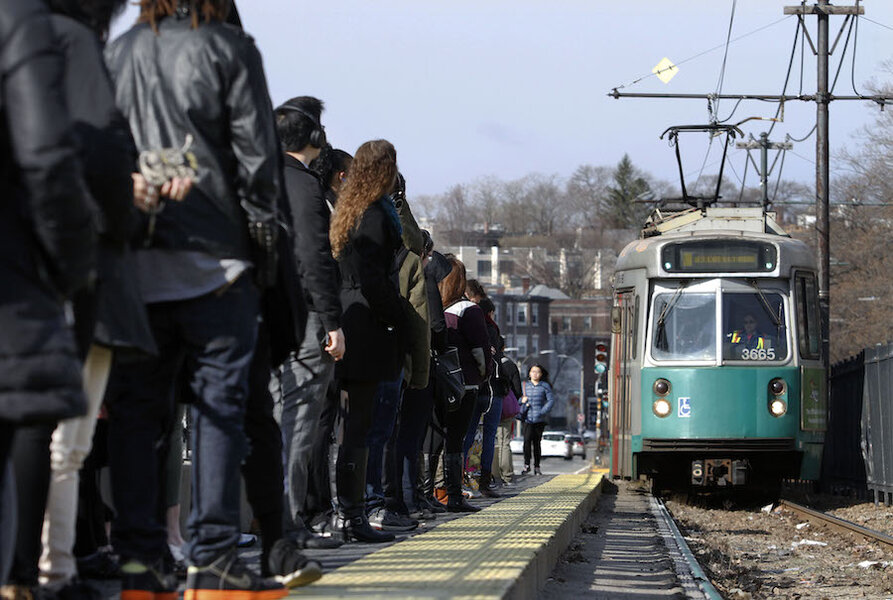With memories of 'Snowpocalypse,' Boston readies for winter
Loading...
During the record-breaking 2015 winter in New England – affectionately known as "Snowpocalyspe" – a series of severe blizzards dumped more than 100 inches of snow on Boston. Retail stores were shut down, residents were asked to stay at home, and driving in the city was banned for a few stretches. Gov. Charlie Baker was forced to call a state of emergency as snowfall topped more than eight feet.
The city's rapid transit service (the T), which an estimated 1 million people in the city depend on for their daily commutes, was largely dysfunctional. Operated by the Massachusetts Bay Transit Authority (MBTA), T service ground to a complete halt during certain periods. Even when it was running, minutes-long ride times stretched into hours; commuters had to be evacuated from one train that got stuck in the heavy snow. Things worsened to the point that the MBTA offered commuters a day of free rides in April to apologize.
As the 2016 winter approaches, memories of 2015 loom large. However, some believe the city's hiccups during that time have helped make Boston better prepared for future extreme weather events by forcing officials to reckon with long-neglected infrastructure problems.
“This last winter has been a blessing in disguise as it illuminated how much we’d neglected the MBTA and how much needs to be done,” says Jose Gomez-Ibanez, a professor of urban planning and public policy at Harvard University.
Boston is not the only major city brought to a standstill by remarkable weather in recent years. In January 2014, Atlanta virtually shut down after a rare few inches of snowfall, resulting in kids sleeping at school and commuters abandoning cars to seek refuge in local stores. California is struggling through a severe drought that has lasted more than four years. And those rare occurrences are only going to become more routine as a result of climate change, experts say.
“Extreme weather events are a natural phenomena, but … as temperatures rise we will expect to see more heavy precipitation events and extreme heat events over much of the country,” says Virginia Burkett, chief scientist for climate and land use change at the US Geological Survey.
That leaves it to local and state governments to shore up their preparation efforts. Last week in Boston, Mayor Marty Walsh unveiled a draft of Go Boston 2030, an initiative meant to engage the public in the process of improving the city's public transit and set targets for the city to meet within 5, 10, and 15 years.
The draft includes lofty transportation goals, such as, “every Boston household will be within a 10 minute walk of a rail station or key bus route, Hubway station, and car-share.” For reliability, the plan aims to ensure that “MBTA customers will experience waits and travel times that are longer than what is scheduled only 10% of the time,” by 2030.
The high goals and community participation (over 6,000 Bostonians gave feedback for the initial draft) mark an attempt to create a comprehensive plan for the future of the city’s public transit and reaffirm public trust in the current MBTA system.
“We learned last winter that in addition to structural reforms, the MBTA needs meaningful improvements to its snow resiliency efforts, including upgrades to infrastructure, operations, and equipment,” Interim MBTA General Manager Frank DePaola said in a written statement.
In June, Mr. DePaola accompanied Gov. Baker and Secretary of Transportation Stephanie Pollack in announcing another initiative prompted by the 2015 winter, an $83.7 million MBTA Winter Resiliency Plan that aims to ramp up snow equipment, implement infrastructure improvements, and increase reliability over the next five years. The plan also calls for Massachusetts state legislators to expand its financial support for the MBTA.
Portions of that plan are already underway. MBTA spokesman Jason Johnson told the Christian Science Monitor via e-mail that the T's Red Line has had “36,929 linear feet, or 51 percent, of [exposed] third rail replaced.” The Orange Line has had over 5,000 feet of snow fencing installed. Snow fencing on the Red Line has a completion date set for Dec. 15.
Boston’s approach to preparing vital public infrastructure for extreme weather events, involving the public and balancing immediate and long-term investments, might be a good blueprint for other cities to follow.
“If we do it right, the investments we make for climate change can also be investments today to make cities better places to live… Boston has been really good at finding those,” says Elisabeth Hamin, a professor of regional planning at the University of Massachusetts in Amherst.








